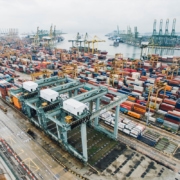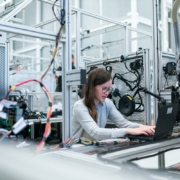American Manufacturers Require Cheap Available Energy to be Competitive
On his very first day in office, President Biden signed an Executive Order canceling the permit for the Keystone XL pipeline. Halting work on the “pipeline in South Dakota immediately eliminated 1,000 union jobs. TC Energy, the company that was developing the project, predicts that more than 10,000 jobs will be lost in 2021 due to the order.” Only a week later, he signed an Executive Order freezing new oil or natural gas leases and drilling permits on federal land. These orders put American energy independence at risk, which will hurt American manufacturers.
Most people don’t realize that there are already thousands of miles of Keystone pipelines that have been completed. According to Wikipedia, Phase 1 started construction in 2008 and became operational in 2010. Phase 1 goes from Hardisty, Alberta, Candada to Wood River and Patoka, Illinois, going through Saskatchewan and Nebraska. Phase 2 goes from Steele City, Nebraska to Cushing, Oklahoma and was completed in 2011. Phase 3 goes from Cushing, Oklahoma to Nederland, Texas and was completed in 2014. A Phase 3b goes from Liberty County, Texas to Houston, Texas and become operational in 2017. If completed, Phase 4 would go from Hardisty, Alberta, Canada to Steele City, Nebraska, passing through Montana. It has been under construction since 2017 after President Trump approved the permit.
Rep. Daines (R-MT) introduced an amendment attached to a COVID-19 relief bill on February 4th to reverse the Executive Order canceling Phase 4 of the Keystone Pipeline. Democratic Sen. Joe Manchin of West Virginia and Jon Tester of Montana initially voted in favor of the Republican amendment, so that it passed 52-48, but later reversed themselves and voted with other Democrats with to kill the amendment. V. P. Harris cast the deciding vote.
American manufacturing has flourished since it started in the 1790s partly because of the availability of cheap energy: Water power was used by the first American industry, textiles. Large water wheels harnessed the flow of a river to provide the necessary power for mills to manufacture the textiles by means of a water-powered spinning frame. Stand-alone steam engines expanded the opportunities to manufacture other products at locations throughout the country in the early 1800s. The discovery of oil in 1859 and the ability to process it into different forms of fuel for a variety of engines and motors accelerated the ability to manufacture a much wider variety of products. These fuels were first used to power the trains and ships that transported goods all over the U.S., creating a mass domestic market for manufactured goods. These fuels were used to power the cars, trucks, and airplanes after they were invented in the early 20th Century. These same fuels were used by companies to power the equipment and machines that manufactured vehicles and airplanes. Then, these new modes of transportation enabled American manufactures to expand their domestic markets and export products worldwide.
With the invention of the Bunsen burner in 1885 by Robert Bunsen, vast new opportunities to use natural gas for energy were created. After “effective pipelines began to be built in the 20th century, the use of natural gas expanded to home heating and cooking, appliances such as water heaters and oven ranges, manufacturing and processing plants, and boilers to generate electricity…Because natural gas is the cleanest burning fossil fuel, it is playing an increasing role in helping to attain national goals of a cleaner environment, energy security and a more competitive economy.”
Prior to pipelines, oil was transported in barrels by wagons or flat boats, and then in wooden tank cars on trains. There was a big problem with leakage of the oil in both barrels and wooden tank cars. A pipeline made out of wooden boards built in 1862 proved equally impractical, but the “first fully successful pipeline—which used wrought iron and highly reinforced joints to transport between 1,950 and 2,000 barrels of oil daily across five miles of land—came in 1865. By the early 1900s, Standard Oil owned 80% of the pipelines.
Regarding pipelines, Wikipedia says,
“Oil pipelines are made from steel or plastic tubes which are usually buried. The oil is moved through the pipelines by pump stations along the pipeline. Natural gas (and similar gaseous fuels) is pressurized into liquids known as Natural Gas Liquids (NGLs).[3] Natural gas pipelines are constructed of carbon steel…Pipelines are one of the safest ways of transporting materials as compared to road or rail…”
For as long as the oil industry has tried to move its products through pipelines, they’ve been contested. At first, it was because private companies were building and controlling the pipelines creating monopolies. Today, it is because environmentalists want to stop the production and transportation of oil and natural gas.
According to the U. S. Department of Transportation,
“The biggest source of energy is petroleum, including oil and natural gas. Together, they supply 65 percent of the energy we use. According to the U.S. Energy Information Administration, oil furnishes 40 percent of our energy, natural gas 25 percent, coal 22 percent, nuclear 8 percent, and renewables make up 4 percent…The nation’s more than 2.6 million miles of pipelines safely deliver trillions of cubic feet of natural gas and hundreds of billions of ton/miles of liquid petroleum products each year. They are essential: the volumes of energy products they move are well beyond the capacity of other forms of transportation. It would take a constant line of tanker trucks, about 750 per day, loading up and moving out every two minutes, 24 hours a day, seven days a week, to move the volume of even a modest pipeline. The railroad-equivalent of this single pipeline would be a train of 225, 28,000-gallon tank cars.”
Notice that renewables, such as solar and wind power, only provide 4 percent of our energy. It’s going to be a long time, if ever, before they can replace the energy provided by oil and gas. Energy experts have estimated it would take 25 – 50 times the number of power plants to provide the energy to charge electric cars when, all new cars and passenger trucks sold in California be zero-emission vehicles by 2035.
Our modern way of life depends on energy. It takes energy to produce the food we eat, the clothes and shoes we wear, to manufacture our household furnishings and appliances, as well as all of the variety of electronic systems and equipment we use. It takes energy to provide transportation for ourselves, as well as to transport all of the products we use by means of cars, trucks, airplanes, and ships. It takes energy to manufacture the equipment and systems used by the military to protect our country. We need Phase 4 of the Keystone Pipeline to be completed and new oil and gas leases be permitted to ensure that our American manufacturers have the energy they need to be competitive in the global marketplace. Without sufficient affordable energy, life as we know it would end.











Great article and spot on! The USA needs to keep independent on foreign imports of oil (and the control those companies have on our economy). We have been on the right track since 2008 and need to finalize phase 4.
There is more to this picture that is stated here. The idea that products that cause extreme damage can be considered “cheap” is only valid if one does not consider the cost of that damage. It is high time that we develop an inclusive business model that considers the long term costs when determining the cost of energy. If we the people have to pay out billions in dollars to clean up the messes caused by this so called cheap energy we are not coming out ahead by one iota. In fact it is quite apparent that this dirty fuel is not cheap at all. If it is such a great business model and makes such cheap energy then of course the manufacturers of said cheap energy would be more than happy to forgo all taxpayer subsidies, including price supports. Rather than drag this filthy dead dinosaur around, perhaps we should look to the future when manufacturers have not only cheap energy but free and clean energy.
It is possible, and it is the right thing to do.
burying your head in the sand while CHINA, Russia, Mexico have ZERO CONCERN FOR ANY ENVIRONMENT while turning your back on American Ingenuity should be a crime. I personally have worked in all power generation industries – We were churning out clean coal emissions by the year 1999 – we have developed even better technologies in the last 20 years – if you think millions of solar panels made with “cheap, lead, glass, plastic, batteries” from china are the answer – well i guess as long as it isnt in your back yard – that’s fine with you – so you continue to be a hypocrit and purchase your CHEAP GOODS MADE IN CHINA – while the oceans are overfished by china and the pollution will end up on the western coast line, but hey – we most certainly dont need cheap dirty fuel here in america – you just might be the problem